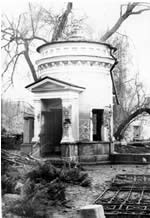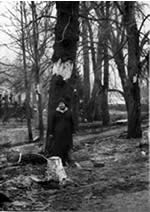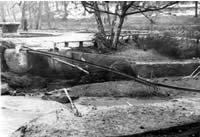ON EXCURSION THROUGH "SOFIYIVKA"
After the book
of І.S.Коsеnko
" Sofiyivka" ,
Uman, 2003,Translated by T.Sukhomeilo |

Main Entrance |
When you come to visit the museum of nature - "Sofiyivka" - you realize that
everything here resembles a fairy tale. It is really so, as the central part
of the park is built on the basis of Greek and Roman Mythology and some places
look like the houses of Greek Gods, writers and philosophers.
According to the architect's plan the park is an illustration to some parts
of the poems "Iliad" and "Odyssey" by Homer. "Sofiyivka" is famous for being
built on a classical basis. Actually, Homer's "Odyssey" is materialized in the
objects of the park. Every composition or a small architectural form is not
only beautiful; it also expresses the idea of a legend or an event; all of this
is well thought and interconnected, smoothly blending into a symphony of beauty.
Probably someone could have a question: why do we, the people of the XXIth
century, need myths of ancient Greeks? O.S.Pushkin, reminding of myths, said,
"every European should have the idea of immortal creations of mighty old times".
How can a reader understand the poem "Proserpine" without knowing the mythology?
The waves of Phlegethon splash,
The vaulting of Tartar tremble:
The horses of pale Pluto quickly rush
To the nymphs of Pelion from God Aid.
To reveal the content sense of the elements of the park's compositions, we
will give explanations concerning various myths, legends and historic events
associated with them, while describing the objects of the park.
When L.Metzel finished building the park, the entrance was from the side of
a greenhouse (i.e., from the campus of Agricultural Academy). Sadova Street
did not exist and people used horses to come to the park. The street appeared
in 1838, when the slope was cut off and a ground road was built; people used
to come to an iron pipe to get some water that flew from Diana's grotto. In
1838 a paved road was constructed from the Lower pond to the entrance (in that
case it was an exit); water was piped out of the park to the source "The Iron
pipe". At the beginning of the XXth century the source disappeared, and as the
archives proved there was supposed to be a hydropathical hospital, then a laundry,
and up to 1994 there was a city water pump station. The work of the source was
restored, its original name was returned; it was part of preparation work to
celebrate the 200-th anniversary of the foundation of the park. It is worth
mentioning that water of this source comes from the central part of the park,
Diana's grotto, the same as it did 200 years ago. As soon as we find ourselves
in the park from Sadova Street, on the left, right behind the entrance tower,
we will see a hill planted with junipers, thuyas, and fir-trees. In this hill,
similarly to those old days, a reservoir was made from which water comes to
"Iron pipe" and to waterfalls with a small saucer of water; architects of the
institute “Ukrengproject” V.B.Kharchenko and O.Humennyi projected it.
It is interesting to know that the first paved road was built in Uman in 1853
and it led from "Sofiyivka" along Sadova Street to the downtown of the city.
In 1844 two towers in gothic style were built at the entrance of the park.
Nicholas I visited the park in 1847, later he issued an order
to remove these towers; instead, in 1850-1852 two entrance
towers in antique style were built based on the project of
architect A.I.Shtakenshneider; along with the entrance gate,
they remained till present time. The fence was changed many
times within the years - from a wooden one on brick columns
to an iron one on granite columns, finally to the way it looks
now with a reconstructed bridge, steps and a tourist complex,
which has a status of House of creative work of scholars of
Ukraine's Academy of Sciences. It was done by the project
developed at Kyiv Institute "Ukrengproject" and in a small
business "Tamiuk" from Cherkasy; it has an original architecture,
and on top of it there is a view site. In addition to a museum,
there is a hotel (which accommodates 45 people), a restaurant,
and sauna, that is, all possible conditions for fruitful work
of research workers both from different cities and countries
at their meetings.
Having participated in the contest conducted by the State Committee of Ukraine
in 1998 concerning constructing and housing policy, the complex took the first
place among the objects of culture.
The upper part of a cone-shaped roof of the towers is crowned with sort of
decoration, which resembles a torch. It caused a version that the Main Entrance
to the park looks like an entrance to Athenian market, and the details on the
watchtowers were borrowed from the temple of Goddess Vista in Tivoli (Italy).
As to the trees that decorated the entrance to the park, they were Lombardy
poplars brought by S.Potocki. It was from "Sofiyivka" that they spread all over
Russia (An archive document confirmed that in 1821 Sofia Potocka sent a number
of Lombardy poplars to Petersburg).
|

The Main Entrance after the calamity.
Photo V.Lozovskiy |
Before the calamity, which damaged "Sofiyivka" very badly (it
happened during the night of April 3-4 1980), the Main Entrance
looked beautiful owing to balsamic fur-trees. They died and
were replaced with two 20-year-old column-type thuyas, which
became part and parcel of the architectural ensemble; they are
strong, stately and underline its significance and solemnity.
People often ask about the cause of the flood and the damages
the park experienced.
The winter of 1979-1980 was snowless and frosty. The ice was
more than 0.7 m thick, and the ground was frozen 1.5 m deep.
Then in March of 1980 heavy snowfalls occurred, and low air
temperature lasted almost to the end of the month. On the first
dates of April the temperature began to rise considerably, as
a result the snow began to melt very fast.
|

Scars on 3-meters height of the trees of the Main Alley
after the water and ice flow passed through.
Photo V.Lozovskiy |
The experts made calculations and a conclusion that even if
all the culverts had been opened two weeks before the flood,
they would not have been able to pass over such a great amount
of melted water from water reservoirs of the park. The flood
washed away a warping-bank in Internatsionalna Street, and all
the water from Krasnostavsky pond (the area is 17 hectares)
rushed along the ice surface of the Upper pond, down along the
Kamianka River where main objects of the park were situated.
It was then that all the granite pylons with vases near the
Main Entrance were destroyed, the right tower was first moved
and then turned round its axis on a granite plinth, almost the
whole right side of the fence fell down.
Although flora of the park was severely damaged (age-old trees
which used to decorate the central part of the park died, other
were very much destroyed), a species composition of plantations
remained. Some trees and bushes (self-sown and not valuable
for park landscapes) died as a result of the calamity. The flood
ruined asphalted covering of the Main alley, destroyed completely
a road-alley system of the park in its lowest part from the
grotto of Thetis to the Main Entrance from Sadova street, all
iron and wooden bridges, locks, some statues and small architectural
forms were removed and destroyed.
|

The rests of the iron bridge to the Assembly Square.
Photo V.Lozovskiy |
The consequences of the flood were liquidated relatively fast, and only injured
bark of the trees in the Main Alley reminds us of the calamity.
As the archive documents prove, "Sofiyivka" experienced floods several times.
For example, in his hand-written guidebook LA.Kazarinov stated that water destroyed
the dam of the Red pond and rushed like a storm across the central part of the
park. He did not mention how much the park was damaged, but he noted that the
park and greenhouses were neglected in 1868-1892; only dry trees were felled
down. In the period of the construction of the park, in spring of 1799 a great
flood occurred, that is why, the opening of the park was delayed till 1802.
Hear the entrance to the park, behind the wall of evergreen thuya a Museum
of the history of the park was situated. The museum began its existence in 1985
being founded by enthusiastic workers of the park, its admirers; the museum
was not planned to have regular attendance. It was a resource center for training
tour-guides. The materials concerning the history of the park were gathered
and kept there. The building, which housed the museum, was built in 1957; it
was used as an administration-laboratory facility till 1980; after that the
building itself was pulled down as
from the point of view of the history it could not be on the territory of the
park. All the valuable materials were moved to an administrative building in
Kyivska Street where they are kept till present time.
Now we can see a beautiful view of granite rocks and a small Geneva Lake, which
appeared in the 30ties of the XXth century. Before that time there was a quarry,
which was closed down at the right time.
Water, stone, grottos, trees grown without any system make an impression of
a natural grove. Recently this hill has been cleared off self-sown trees and
bushes of local and unimportant species; a distant prospect of a wonderful sight
- Mushroom glade, with natural stones on the surface - was opened.
T.Themery (Themery, 1846) wrote that in 1841 a wooden pergola for a guard soldier
was built; it resembled a mushroom, and due to this fact the whole area on the
right hill was called "Mushroom". The pergola was restored in 1994.
Further. On the foreground of a landscape a group of fir-trees and a bald cypress,
a unique exotic plant, a guest from a far-remote American continent, attract
attention. These trees were planted in 1891.
Presently the guides pointing to the area of the park from the Main Entrance
to Tarpeian Rock call this part Little Switzerland. L.O.Kazarinov mentioned
this name for the first time in his hand-written guidebook.
It has become known from the archive documents that this part of the park got
its accomplished view in the period of Military settlements, after the entrance
towers had been built. We think that the authors tried to reflex the nature
of Scotland rather than that of Switzerland. Our assumptions could be based
on Ossian motives, which could be traced in one of the first works about the
park - in a "Guidebook across "Sofiyivka" written by T.Themery (Themery, 1846).
After the laudatory odes to Sofia, her husband, poet Trembecki and architect
L.Metzel, the author, referring to French translation of de Leggard's poem about
"Sofiyivka", mentions the names of Malvina and Ossian, as if asking whether
they are somewhere on severe rocks of "Sofiyivka". Further, in his notes to
the guidebook, T.Themery explains who Ossian is and adds a set of poems about
him being translated from Scottish to French; he also mentions another hero
of this epic work - Fingal. Our assumptions are based on research work done
by a famous expert in park science, the author of the book "Poetry of gardens",
D.S.Lykhachov. He considered "Sofiyivka" and Vorontsov Park in Alupka along
with other outstanding parks in Russia to be the examples of late romanticism;
they were definitely affected by Ossian moods.
Admiring the park and its wonderful sights, let us get acquainted in brief
with Ossian motives (where they are from, how they appeared in art, what they
mean).
| |
 |
 |
| The park, as a scientific institution of the National Academy of Science of Ukraine, is engaged in researches of connatural and cultural flora of austral Forest-steppe of Ukraine, introduction and acclimatation of plants in the region. The article of the director of the famous park I. Kosenko summarizes this work: |
| 50 years anniversary of the Sofiyivka park as a scientific institute of the Ukraine's NAS |
|
| In the final article of I. Kosenko the review of the park's whole history from the moment of the foundation till todays is made: |
| 205 years since the foundation of Sofiyivka |
|
| The team of scientists of the park issued the catalogue of plants with the total amount 1994 taxons, in which 25 taxons of hazels, 24 beeches, 41 fir-trees, 44 junipers, 100 lianas, 320 roses, 57 rhododendrons and 98 flower plants - totally 1220 trees and bushes and 774 herbaceous plants.
|
| Catalogue (zip 380 КB) |
|
| The hothouse of the park is the unique center of cultivation of conifers and deciduous trees, bushes, roses seedlings - total more than 200 items. |
Price-list
Open|Download (22 КB) |
|
| The beauty of the park was sung by a lot of poets, but the poem of the Polish poet S. Trembecki occupies an especial place. Written in 1811, it is the park guide book in verses.
"Sofiowka" and comments of Adam Mickiewicz (polish) |
|
| Park as the tourist center offers the visitors a complex of services - excursion support in six languages, hotel, restaurant, conference hall etc. | | List of services |
|
|